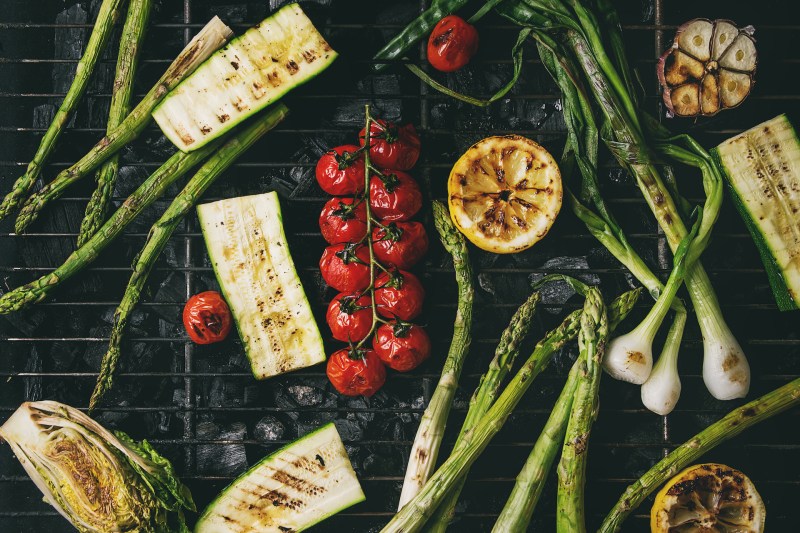
When contemplating all of the delicious ingredients to grill this summer, things like burgers, steaks, brats, and ribs may be the juicy, meaty images floating through your mind – and for good reason. There’s something absolutely magical about charred, smokey meats straight off the coals. But that savory grilled flavor doesn’t begin and end with meat. In fact, your entire meal can (and should) be made all together on the grill, proteins, sides, and all. And one of our favorite smokey sides is grilled vegetables. Grilled vegetables are truly something special and very easy to prepare if you follow a few simple guidelines.
So, when stocking up on your favorite barbecue fare this weekend, don’t forget to make a stop in the produce section. Because grilled vegetables are about to become your new favorite side dish.
How to prepare vegetables for grilling

With most foods, an even surface is required for even cooking. Vegetables are no exception to this rule, though, due to their varying and sometimes quirky shapes, an even surface can be tricky to achieve. While not all vegetables require cutting before grilling (such as corn), for those that do, large, even pieces are best. To prepare your vegetables for the grill, cut them into large, even pieces big enough to sit on the grill grates without falling through.
Something else to be mindful of when grilling vegetables is that they cook at different rates. A wedge of tomato, for example, will take far less time to cook than a sturdier vegetable like an onion or bell pepper. When placing your ingredients on the grill, be sure to give the more hearty ingredients a bit more time, adding the more delicate vegetables later in the cooking process.
To ensure even cooking for your vegetables, skewering them is both a great way to cook and a fun way to serve them. Just be sure to group like vegetables together that will cook at the same rate to avoid over or undercooking ingredients. While this version of a kabob is admittedly not as Insta-worthy as others that are packed full of varying colors and ingredients, it’s the best way to ensure your ingredients are cooked evenly.
After your vegetables have been cut and/or skewered, brush them with a neutral oil such as vegetable or canola, season, and grill.
Best cuts for grilling vegetables
Bell peppers: Seeded and cut into halves or quarters
Onions: Peeled and cut into halves or quarters
Yellow squash, zucchini, and eggplant: Sliced lengthwise into rectangles at least 1/2-inch thick
Large mushrooms: Stemmed and halved
Asparagus: Trimmed of ends and grilled whole
Tomatoes: Whole, on the vine
How to grill vegetables

One of the fun parts of grilling anything is using both direct and indirect heat, expertly maneuvering your ingredients between the two. To properly grill vegetables, it’s important to understand the difference between these two forms of heat and how you can use them to make deliciously grilled vegetables.
Cooking over direct heat means cooking the ingredient directly over the grill’s flame, allowing it to come in contact with the fire.
Cooking over indirect heat means cooking the ingredient away from the flames, either by way of space or something coming between the ingredient and the fire, such as aluminum foil.
For vegetable grilling, a combination of both direct and indirect heat is best. We like to start vegetables over direct heat, developing a good sear or char on the ingredient, and then move it to indirect heat so that it can cook through.
The time it takes to cook your vegetable will depend on its size and shape, but we’ve created a general guideline to help you get started. For each of these ingredients, begin cooking over direct heat for the first half of the cooking time and then switch to indirect heat for the last half.
Cooking times for grilled vegetables
Bell peppers: 8-10 minutes
Onions: 8-10 minutes
Yellow squash, zucchini, and eggplant: 6-8 minutes
Large mushrooms: 6-8 minutes
Asparagus: 4-6 minutes
Tomatoes: 4-6 minutes
How to serve grilled vegetables

Because of the deliciously smokey flavor provided by the grilling process itself, grilled vegetables rarely need more than a bit of salt and a spritz of citrus after their trip through the flames. However, we absolutely love to serve grilled vegetables with an earthy homemade pesto or zippy chimichurri for a fresh, green bite. Alternatively, a cooling, creamy dipping sauce like tzatziki or homemade ranch is also delicious.
Serve your grilled vegetables alongside any of these dips, or simply piled atop your favorite grilled protein for an unforgettable barbecue.



